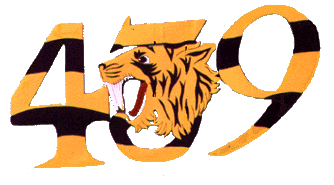|
History
of
 Squadron Squadron
  
Chapter
VI
Winter in the Netherlands
November 1944 January
1945
Montfort, a small town in the angle between the Maas and the Roer, about five miles south west of
Roermond, was attacked by the whole Wing on 21 January, with No.
439's nine aircraft going down first. The bombing was good, and it was believed that the movement of enemy transport through the town would be blocked.
F/O Walt Kubicki had a hang up on his first run, but he made a second try and scored a direct hit
"smack on the main road." Close support work for the Army reached its peak on the 22nd with three attacks on towns and villages in the salient west of the Roer which brought congratulations from 12th Army Corps. ln the morning the whole wing bombed Heinsberg, No. 439's eleven
aircraft being allotted a factory as their special objective. Four l000 lb. bombs hit the factory, four more were near misses, and the others fell on a cluster of buildings nearby. Early in the afternoon the wing made a second attack on Montfort which completed the destruction of the town.
"Nothing was left but rubble, fires and smoke" when the three squadrons departed. Then, at 1610 hours,
two squadrons went out to blast Uetterath, a village near Heinsberg, about four miles from our advanced troops.
|
Intentionally
left blank
|
Intentionally
left blank
|
On the previous operations that day there had been very little flak; this time, however, the barrage was concentrated and accurate. S/L Crosby started down in a vertical dive from 8000 feet at the head of his formation and was seen to release his bombs at 6000 feet just after the Typhoon was struck by 40 mm. slugs. As his bombs dropped the aircraft disintegrated in the air, hitting another Typhoon with
flying debris. Blue section, coming down after Red, continued their dive to 4000 feet and got at least three sets of bombs in the middle of the target. The return to base was made without further misadventure, except for Walt Kubicki who
force landed with engine trouble some miles from Eindhoven.
The Army later reported that they captured 600 prisoners in the villages which the Typhoon wing had bombed. The apparent loss of their leader was a great blow to the squadron; no one who saw his aircraft explode held any hope that
"Bing" had survived. There had been several of these mysterious explosions in the past few weeks,
and it was noticeable that the newer pilots were bewildered, shaken,
and suspicious of the Typhoon's safety. It was therefore not only a cause of great pleasure but also a decided boost to morale when a few days later news personal was received that S/L Crosby had miraculously escaped death.
|
|
From a hospital bed in Hasselt he was able to give a "blow by blow" account of what happened that afternoon over
Uetterath. Thrown clear in the explosion of his aircraft,
"Bing" tried to pull the rip cord of his parachute. When nothing happened after two attempts he discovered that his right hand was useless. With his left hand he managed to release his parachute and came to earth near the village he had been bombing.
Quickly rolling up his 'chute he took cover in a wood nearby where he remained for 36 hours, wrapped in the folds of the parachute and suffering intense pain from a dislocated right shoulder. German soldiers worked at times within a few feet of his hiding place. On the 23rd Uetterath was dive bombed again by Nos. 438 and 440 Squadrons, some of the missiles falling so close that Crosby was shaken and covered by dirt and debris. Early the next morning
"Bing" decided to head for the British lines which were about four miles away. Eluding enemy sentries, he staggered on to our outposts and was soon safe in hospital for treatment of his shoulder and frost bites suffered during his period of hiding.
S/L Crosby was nearing the end of his tour when he was injured. With No. 56 Squadron he had done 21 sorties before the interruption of a parachute descent and evasion. Since joining 143 Wing he had added
a further 63 sorties, and had just been recommended for the D.F.C. The recommendation was approved and
"Bing" became the eighth member of the squadron to receive the purple and white ribbon.
"During a lengthy operational career, this officer has attacked the enemy with determination on a wide variety of sorties. He has led fighter patrols, anti shipping missions, armed reconnaissances and
dive bombing operations against railway sidings, strong points and enemy troop concentrations. During the recent German offensive in Belgium the squadron, under his leadership, destroyed or damaged
a large number of enemy vehicles and shot down six enemy fighters in three days. S/L Crosby has invariably led his squadron with outstanding courage and determination even against the most
heavily defended targets."
  
Copyright
©1998-2016 Michael T. Melnick. All rights reserved
the
unofficial homepage of  Tiger
Squadron Tiger
Squadron
.
.
|
|